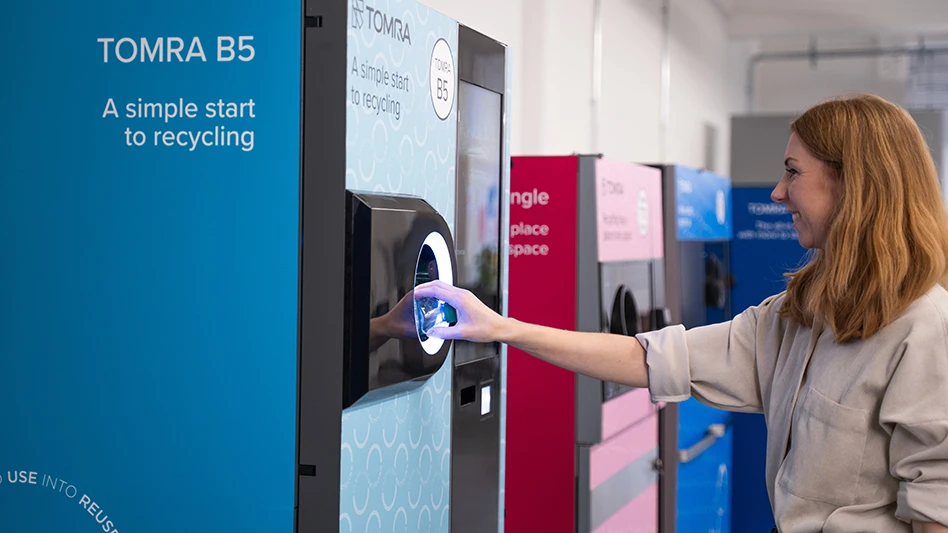The environmental and economic traits of cell phone remanufacturing, the demanufacturing of military electronics and a cost benefit analysis of plastic separation were discussed.
Philip G. Churchill with the National Defense Center for Environmental Excellence, Demanufacturing of Electronic Equipment for Reuse and Recycling (DEER2) Project, Largo, Fla., reported that approximately 22.7 million pounds of government excess electronics were sent to demanufacturing contractors during the 2001 fiscal year. The DEER2 project has developed techniques for use in the demanufacturing electronics and has conducted technology demonstration and validation tests on about 40,000 pounds of these items, he said. Fifteen million pounds were reconditioned for reuse and donated to state and local police departments and nonprofit organizations, he added; however, he pointed out that the rapidity of technological advances has lead to a reduction in electronics reuse.
Churchill said that some electronic equipment is eligible for resale to the public through the Commercial Venture II Program, which operates a Web site where equipment is shown in lot sizes for sale.
Two contractors are currently approved to bid on each task orders for demanufacturing, Churchill said. Demilitarization, or the destruction of military materials or sensitive technical data, may be required in some cases. “Contractor sites are required to have a government employee acting as a verifier during all demilitarization activities,” he said. “The other required participant in the demilitarization validation acts as the certifier and may be a trained contractor employee under the current contract. Both the verifier and certifier attest to the completeness of the demilitarization conducted at the contractor site.”
However DEMIL coding is not error free. Churchill reported that among the chronic problems associated with DEMIL codes are the miscoding of items requiring DEMIL; the lack of knowledge among the acquisition community pertaining to proper DEMIL coding; a lack of personal accountability and communication between item managers and the Defense Logistics Information Service; and the needless demilitarization of common hardware. He added that DEMIL coding makes the recovery of copper and gold impossible.
Of the military electronics collected in 2001, 3 million pounds went to UNICOR, a division of Federal Prison Industries Inc. (FPI), for recycling. In 2002, the figure was approximately 17 million pounds. According to Churhill’s paper, “FPI UNICOR has filled a niche, especially with their capabilities to separate and recycle leaded from unleaded glass. This program will probably continue to be supported due to low cost processing and superior recycling capabilities provided to the DoD by FPI UNICOR.”
During the question and answer period following Churchill’s presentation, many audience members voiced their displeasure concerning the DoD contract with UNICOR, asserting that the cheap prison labor UNICOR provides gives them an unfair advantage over commercial recyclers. Churchill responded that UNICOR offers the security necessary for demilitarization and demanufacturing without the overhead of a commercial recycler.
W. Ross Morrow, a graduate student in the Department of Mechanical Engineering at the University of Michigan, Ann Arbor, then discussed the remanufacturing of cell phones. Morrow said that while third party demanufacturers in the U.S. can be profitable, OEMs can remanufacture cell phones more efficiently, reducing technological and logistical burdens.
Most cell phones available for remanufacturing suffer from “stylistic obsolescence,” Morrow said, meaning that while the phones still function properly, they are missing some of the newer capabilities and features. Remanufacturing, therefore, does not reduce the amount of newly manufactured phones produced, because they are not considered replacements.
The study Morrow helped to conduct also found that distribution of the remanufactured cell phones had more of an environmental impact than the act of remanufacturing, as many of the phones were shipped overseas to Africa and South America. According to Morrow’s paper, “Rather than reducing environmental impact, it is highly probable that the availability of remanufactured cellular telephones will have a major, and negative, impact on the environment through the so-called ‘rebound effect.’ The vast majority of remanufactured cellular telephone customers are first-time users, for whom the low cost of the remanufactured cell phones serves as a conduit for entry into the market. Consequently, new use-phase, transportation and end-of-life environmental impacts are created where they did not exist before, adding to the net environmental impact of the industry.”
Morrow added that cutting off the flow of remanufactured cell phones to developing countries would not be an acceptable means for protecting the environment, as there is a strong correlation between teledensity, or the number of main telephone lines per 100 people, and GDP and the level of human development.
Remanufactured cell phones may also hold less charge than the original phones, with rates ranging from 80 percent to 100 percent. “Continued implementation of more energy-efficient technology in new cellular phones will further increase the relative inefficiency of remanufactured product,” Morrow said.
“While remanufacturing would help OEMs address aspects of WEEE, it would lead to a large environmental burden shifted to cities with lesser regulatory or infrastructure capability to properly handle potentially hazardous electronic waste,” Morrow said. However, he added, mobile communications are expected to play an important role in the economic and social development of these areas, and that the impact of remanufacturing will require further delving into the ethics of pollution.
Finally, Julie Ann Stuart of the School of Industrial Engineering, Purdue University, West Lafayette, In., addressed developments in plastic separation technology and electronics disassembly.
Stuart said that 16 plastics can be found in disassembled electronics. Contamination remains a problem, which is why Stuart set out to study effective means for identifying and sorting the plastics recovered from electronic equipment.
Raman spectroscopy can be used to identify plastic types, Stuart said. Once an absorption data fingerprint has been added to the machine’s database, it can be used to identify the resin type in a matter of seconds. However, Raman spectroscopy does represent a considerable capital investment for a recycler or demanufacturer.
Considerable labor costs also contribute to negative plastics recycling economics. Using methods time management testing, which measures the standard time it takes for an experienced worker to perform a given task, Stuart determined that basic disassembly of the exterior housing and the removal of hazardous and valuable components, is more cost effective in terms of plastic recovery than extended disassembly, which includes the removal of interior components that are not time (taking more than 30 seconds to remove) or tool prohibitive.
Much of the plastic can be recovered with basic disassembly, Stuart said. “I can’t say that one specific manufacturer in one particular year will give you great return,” she added.
The 2003 Going Green International Congress & Exhibition was held in Boston May 19-22. The show is a combination of the IEEE (Institute of Electrical and Electronics Engineers) International Symposium on Electronics and the Environment and the IAER (International Association of Electronics Recyclers) Electronics Recycling Summit.
Latest from Recycling Today
- ReMA urges open intra-North American scrap trade
- Axium awarded by regional organization
- China to introduce steel export quotas
- Thyssenkrupp idles capacity in Europe
- Phoenix Technologies closes Ohio rPET facility
- EPA selects 2 governments in Pennsylvania to receive recycling, waste grants
- NWRA Florida Chapter announces 2025 Legislative Champion Awards
- Goldman Sachs Research: Copper prices to decline in 2026





